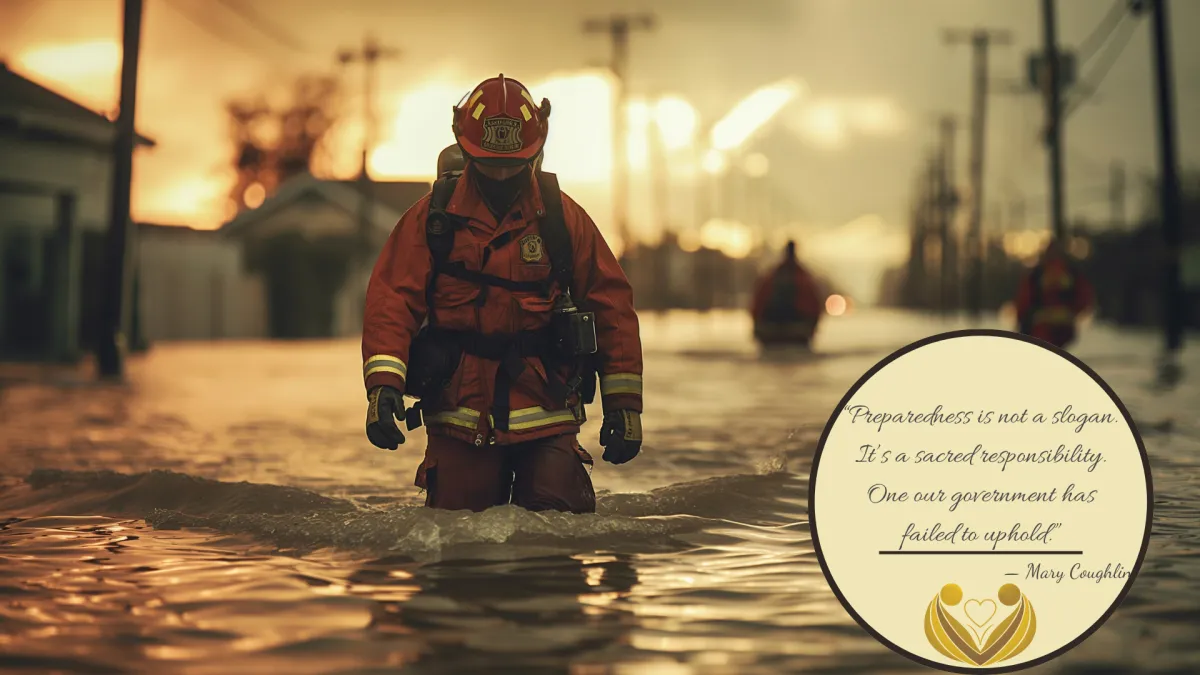
Prepared to Fail: How FEMA’s Shifting Priorities Leave Communities Exposed
“Preparedness is not a slogan. It’s a sacred responsibility. One our government has failed to uphold.” — Mary Coughlin
Prepared to Fail: How FEMA’s Shifting Priorities Leave Communities Exposed
What happens when resilience becomes rhetoric—and prevention is defunded.
A Brief History of FEMA’s Promise
1. DOGE Cuts Weakened FEMA’s Capacity
What happens when resilience becomes rhetoric—and prevention is defunded.
We are told FEMA is our safety net in a climate-exacerbated world. That it protects us before the crisis begins and responds when it hits hardest.
But what happens when that promise is stripped away before the first raindrop? What happens when the very agencies meant to shield us are weakened by design?
This isn’t speculative. It’s visible in every town left unprotected, every pre-disaster grant delayed or defunded, and every family left drowning—not because weather is too strong, but because systems were too brittle.
A Brief History of FEMA’s Promise
Founded in 1979, FEMA’s mission was once narrow and clear: respond to disasters.
But in the wake of mega-disasters like Katrina and Sandy, FEMA’s mandate expanded to include mitigation—investing in resilience before disaster strikes.
Programs like BRIC (Building Resilient Infrastructure & Communities) became vital tools for funding early-warning systems, drainage upgrades, and flood defenses.
The Quiet Dismantling
1. DOGE Cuts Weakened FEMA’s Capacity
Through early 2025, the Department of Government Efficiency (DOGE)—an executive-led axe wielding operation—slashed ~20% of FEMA’s workforce and froze key grant programs and administrative support.
These internal cuts eroded capacity to manage and deploy pre-disaster funding.
Dogecoin-themed acronym aside, this was serious structural damage:“FEMA and other federal agencies are struggling… because of Trump administration cuts” (politico.com, washingtonpost.com, planetdetroit.org).
2. BRIC Gets Canceled
In April, FEMA abruptly ended the $750 million BRIC program, even canceling previously approved projects.
This wasn’t a pause—it was dismantlement. Projects worth $3.6 billion evaporated.
Communities like Bridgeport and California cities lost critical funding.
FEMA called BRIC “wasteful, politicized.” Others called it essential.(eenews.net, planetdetroit.org)
The Real-World Toll
Counties across America—many of which voted for the current administration—lost storm-prep funding, leaving them underprepared for floods, fires, and hurricanes (cbsnews.com).
Smaller rural and low-income communities, which lack grant-writing infrastructure, were systematically left out.
FEMA’s pivot to crisis response has left little capacity for strategic mitigation, especially in underserved areas.
People know they could have been safer if funding and foresight existed. This is more than negligence—it’s betrayal.
The Trauma of False Protection
We’re told to “be resilient.” But resilience without support is just survival—it’s repeated trauma.
When communities are taught to prepare, only to be told “no money,” the message is clear: your lives aren’t a priority.
A Trauma-Informed Call to Accountability
This isn’t about blame. It’s about acknowledging truth—then doing what’s needed:
✔️ Restore and fully reinstate BRIC funding ($750M+ per year)
✔️ Re-hire FEMA’s frontline capacity, not just crisis staff
✔️ Deploy mitigation grants equitably, prioritizing vulnerable communities
✔️ Commit to long-term planning, not short-term media cycles
✔️ Center community voices—those who have lived through the harm
Because when prevention is treated as optional, we’re not safer—we’re just waiting for the next disaster.
With fierce care and unwavering clarity,
Mary
